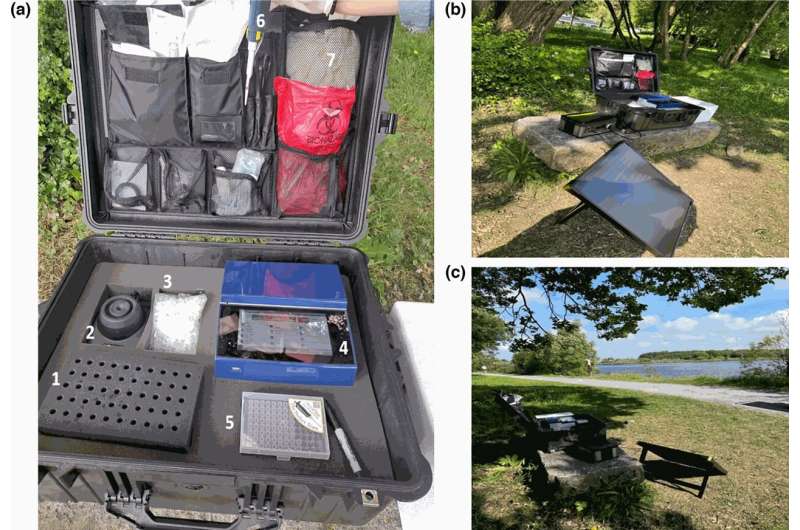This article has been reviewed according to Science X's editorial process and policies. Editors have highlighted the following attributes while ensuring the content's credibility:
fact-checked
trusted source
proofread
Researchers create new device for on-the-spot water testing

Researchers at University of Galway have developed a new, portable technology for on-the-spot testing of water quality to detect one of the most dangerous types of bacteria.
Ireland regularly reports the highest crude incidence rates of the pathogen Shiga toxigenic Escherichia coli—STEC for short—in Europe over recent years.
The bacteria produces the harmful Shiga toxin, which, if ingested by humans, can cause severe stomach illnesses and, in some cases, life-threatening complications, especially in children under 5 years, older people and immunocompromised individuals.
A work led by Dr. Zina Alfahl, lecturer in bacteriology in the University's College of Medicine, Nursing and Health Sciences, and Dr. Louise O'Connor, senior research fellow with the University's College of Science and Engineering, developed a technology for rapid, sensitive and accurate testing of STEC in water sources, including rivers, lakes and wells.
The results have been published in the journal, Microbiology.
Dr. Alfahl said, "Our technology is a significant advancement in on-site water testing. It is portable, straightforward and safe to use. It is accurate, highly sensitive and the results are delivered quickly, on-site.
"We are hoping that Environmental Health Officers and groundwater schemes in Ireland could use the technology on-site allowing for more frequent testing especially in or after extreme weather, periods of intense rainfall, because it is those conditions which lead to water supplies being contaminated."
Dr. O'Connor said, "This technology could be a crucial intervention in helping to prevent outbreaks of infection in families and communities using wells, private water supplies and groundwater schemes.
"Immediate results can help public health officers and water management authorities make informed decisions to protect public health. This rapid response capability is crucial for preventing the spread of waterborne diseases and ensuring the safety of drinking water."
STEC is normally found in the intestines of healthy animals like cows and sheep, which carry it without getting sick. The bacteria spreads to people through contact with animal waste, or by eating or drinking contaminated food or water.
A small sample of water can be tested on-site using isothermal amplification technology which can identify the genetic markers of STEC bacteria, and related E. coli. The results are delivered in about 40minutes through a reading on screen. Traditional lab testing of samples can take days for results to be returned.
The research tested samples from various water sources, including groundwater wells, rivers, a turlough and a farm drain on the Corrib catchment in Galway. Of the samples tested, 61% were positive for the presence of this dangerous pathogen.
Dr. Alfahl said, "Our testing is sensitive enough to identify as low as two cells of the STEC bacteria. The gold standard for testing is culture in a lab, but this can take days and often weeks, and on occasion can return a false negative result—just because the culture does not grow in the lab does not always mean the bacteria has not been present in the water.
"Our test removes the necessity for samples to go to a lab. It offers on-the-spot results and is of huge benefit to the people using the water as a first-step in identifying a contamination and a potential health risk."
Dr. O'Connor said, "This new testing method is particularly important for areas that rely on private groundwater wells, which can be more prone to contamination. In Ireland, a significant portion of the population depends on these for their drinking water—about 720,000 people, or one in every 5 households, but quality has been an issue as regulation is less stringent on these sources and testing is less frequent."
More information: Zina Alfahl et al, A rapid on-site loop-mediated isothermal amplification technology as an early warning system for the detection of Shiga toxin-producing Escherichia coli in water, Microbiology (2024). DOI: 10.1099/mic.0.001485
Provided by University of Galway


















